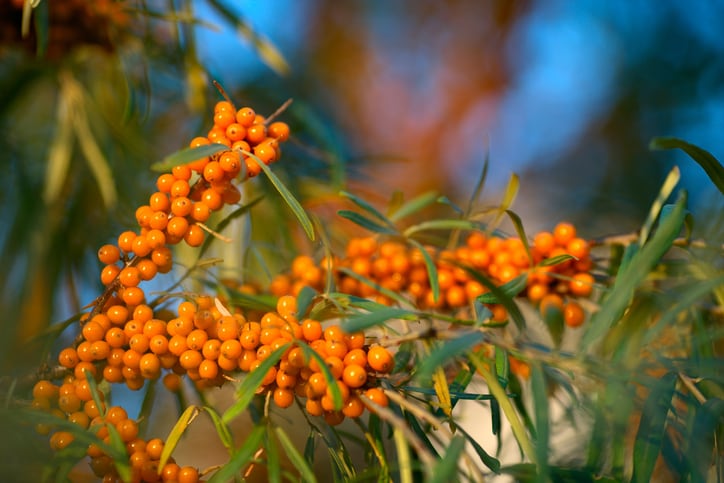To establish the antioxidant capacity of fermented sea buckthorn juice (FSBJ), scientists optimised the probiotic ratio for improved efficacy and examined the protective effects, compared to control cells with induced oxidative stress (H2O2).
FSBJ increased intracellular superoxide dismutase (SOD) and glutathione peroxidase (GSH-Px) activity and reduced both reactive oxygen species (ROS) and malondialdehyde (MDA) content, as well as catalase (CAT) activity, the authors note in Frontiers in Nutrition.
“The results indicated that antimicrobial properties increased during fermentation and that the fermented juice had higher antibacterial properties,” they write.
“FSBJ had more significant antibacterial and antifungal activities than SBJ, which may be related to the production of organic acids and bacteriostatic proteins during the fermentation.”
Cost-effective solution
Sea buckthorn (Hippophae rhamnoides L.) is a celebrated medicinal therapy in China used to treat and prevent Alzheimer’s disease, cardiovascular disease, gastric ulcers, cancer, and skin problems. Active ingredients include flavonoids, polysaccharides, polyphenols, organic acids, vitamins, and amino acids.
Fermentation is a cost-effective process that “converts complex organic compounds into simpler ones through the growth and metabolic activity of probiotics, such as lactic acid bacteria and yeast”, the authors explain.
The process tempers the sour and astringent taste of sea buckthorn, making it more palatable, and may enhance the performance of bioactive substances while diminishing the activity of undesirables, they say.
“The pharmacological activities of many bioactive substances are enhanced under the action of probiotic biotransformation. Therefore, there is value in researching and developing a processing method for sea buckthorn fruit that is cheap, beneficial for improving its flavour profile, and adds to its nutritional value.”
Research design
Six probiotic strains (Zymomonas Mobilis, Lactobacillus Casei, Lactobacillus Plantarum, Pediococcus Acidilactici, Lactobacillus animalis, Pediococcus Pentosaceus) were chosen for in-vitro analysis based on high SOD production capacity, high total flavonoid content (TFC), and high flavour profile.
Sea buckthorn berries were supplied by Xinjiang Huize Food and assay kits sourced from the Jiancheng Biotechnology Institute. Anaerobic bacteria were obtained from the China General Microbiological Culture Collection Centre.
The optimal percentage of inoculum was established and - based on preliminary results - the fermentation process optimised using SOD and TFC indicators. Antibacterial and antifungal activity of FSBJ was measured using response surface methodology (RSM) and analysis of MDA content and SOD, CAT, and GSH-Px cell activity.
Dominant strains and variance
Total flavonoid, SOD, and sensory scores of strains inoculated with L. casei, L. plantarum, and L. animalis was higher after fermentation, suggesting FSBJ is capable of producing more pleasant flavour substances.
“Explanations for these differences could include differences in strain growth rates, optimal growth environments, and carbon source utilisation,” the authors write.
RSM analysis confirmed fermentation time, quantity of added sugar and inoculum amount influenced SOD activity and TFC, and temperature “had a significant impact”.
They note that: “SOD activity reached its peak of 698.94 U/mL at 37oC, and then decreased as the temperature rose. TFC also reached its highest value of 2.49 mg/mL at 37oC and declined rapidly thereafter.”
Moreover, 3% added sugar promoted bacterial growth and maximised SOD activity, which increased to 720.78 U/mL.
Reparative effects
Results were consistent with previous research on increased antimicrobial and antibacterial properties of fermented fruit juices, the authors report.
“Experiment data showed that SBJ still had bacteriostatic activity, indicating that sea buckthorn originally contained components with bacteriostatic activity, such as polyphenols, flavonoids, and organic acids.”
However, after fermentation bioactive content increased, “which may have led to the observed increase in activity of FSBJ,” they say.
MDA content decreased significantly, and cell survival rates improved with FSBJ treatment, compared to the control. In addition, flow cytometry analysis confirmed significant reductions in ROS.
“FSBJ protected cells against lipid peroxidation caused by ROS, thereby alleviating cellular oxidative damage caused by the free radicals. Results imply that FSBJ intervention effectively reduces ROS production induced by H2O2 and hence contributes a reparative effect on damage caused by cellular oxidative stress.”
On the other hand, the study represents a preliminary analysis and questions remain, the authors assert.
“It still remains unknown how the antioxidant substances in sea buckthorn change during fermentation, as well as the protective mechanism underpinning the antioxidant effect in vivo of FSBJ, so these warrant further investigation.”
Source: Frontiers in Nutrition
Published online, January 20, 2023: http://doi.org/10.3389/fnut.2023.1120748
‘Development of fermented sea buckthorn (Hippophae rhamnoides L.) juice and investigation of its antioxidant and antimicrobial activity’
Authors: Xiaolu Liu, Mingshan Lv, Ruxianguli Maimaitiyiming, Keping Chen, Nuersiman Tuerhong, Jiangyong Yang, Aihemaitijiang Aihaiti and Liang Wang

